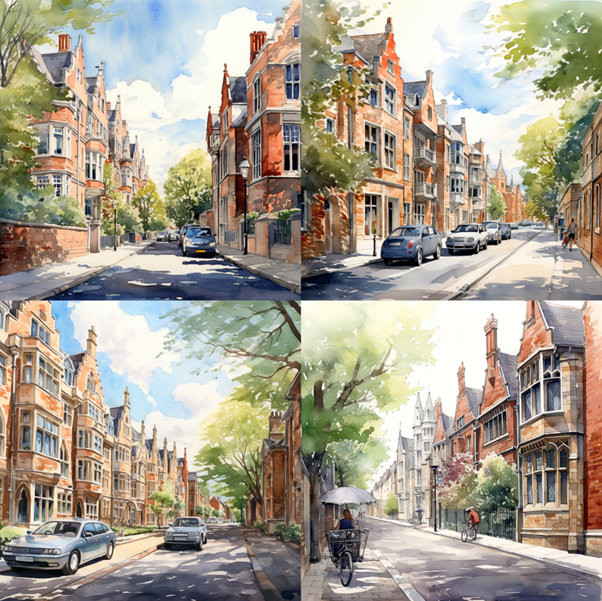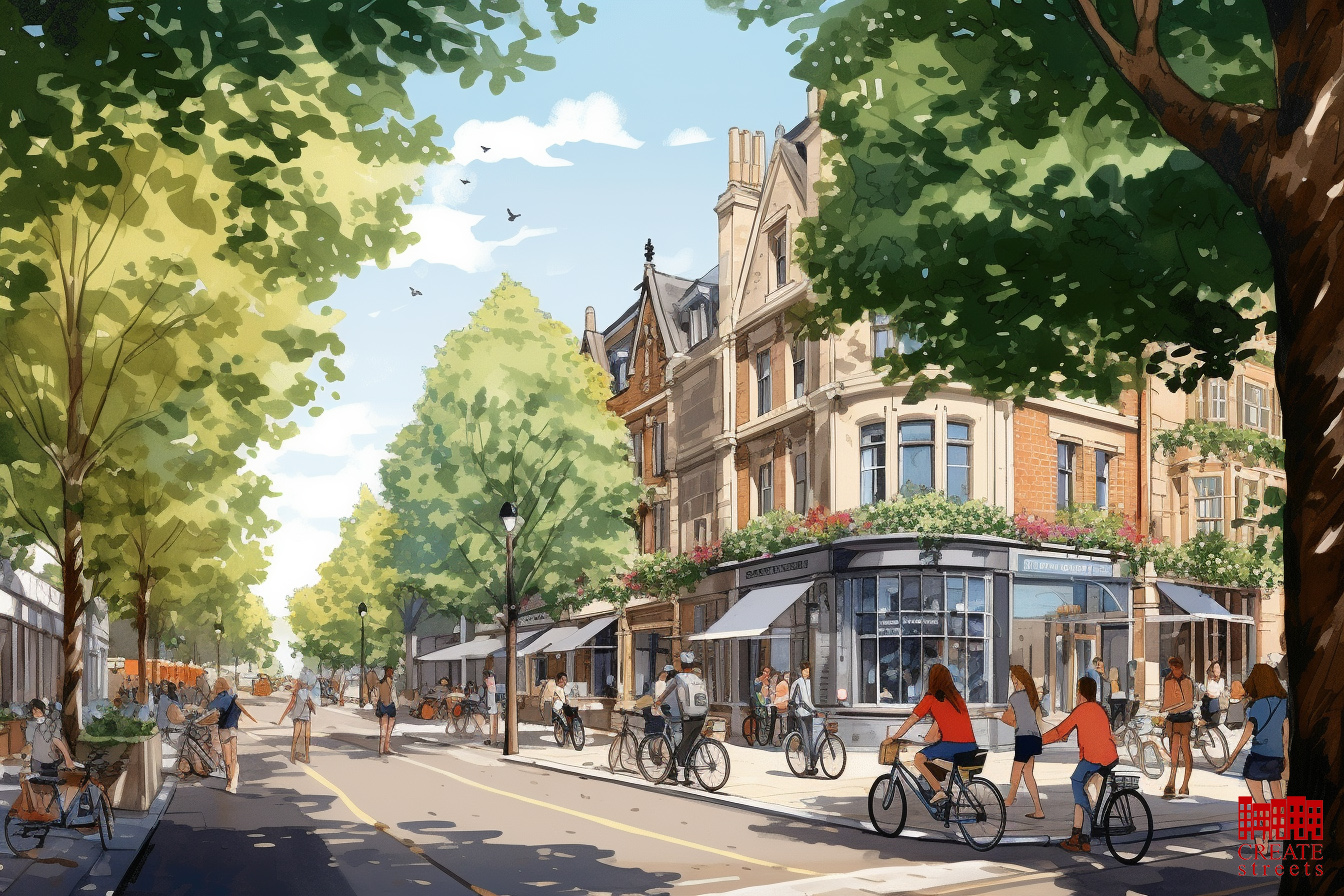Gentle density in the best tradition of Cambridge. Create Streets
Create Streets fellow, Samuel Hughes, reviews today’s announcement on Cambridge development…
One of Britain’s familiar problems is a failure to build homes and laboratory space in Cambridge. As everyone knows, Cambridge leads the world in many research fields, and this research generates huge numbers of vital business start-ups. As everyone also knows, it is adding homes and laboratories far more slowly than the comparable American centres, causing the price of homes and laboratories to spiral. In the medium term, this will strangulate it, destroying one of Britain’s key assets. As with many of Britain’s problems, this disaster is fatalistically accepted as inevitable.
Then this morning, something odd happened: the Government announced that it is actually going to solve this problem. It wants to massively expand Cambridge, creating a dense new quarter with a mixture of laboratory space and housing. Neither the site nor the delivery model are yet clear, so it could all yet come to nothing. But there are perfectly good options available: if the Government actually wants to solve this problem, it really can do so. The announcement is all the more surprising in that it seems to come from nowhere (though actually, it may have come from me, albeit using a potentially different mechanism).
I think this morning’s announcement was interesting and important, both for its own sake and for the light that it sheds on the Government’s thinking on housing. If the Government sticks to this approach, it could have far more housebuilding success than its predecessors, even with the limited time and political capital remaining to it. To understand why, we need to step back and look at what Britain’s housing shortage actually consists in.
****
We tend to talk about a national ‘housing shortage’ or ‘housing crisis’. This is not wrong, but it is potentially misleading. Britain’s housing shortage is overwhelmingly concentrated in certain parts of the country, chiefly in London, Oxford, Cambridge, and towns in their commuting zones. In Oxford or Cambridge, a square metre of floorspace is typically worth £4,000 or £5,000. In Inner London, it can easily be worth £10,000, and there are areas in which it is worth £2,000. In huge areas of the North, however, a square metre of floorspace is worth little over £1,000; in the poorest areas of the Vale of Glamorgan, its average value falls to about £650.
This fact should be absolutely fundamental to how we think about housing. Our great problem is not that the country as a whole does not have enough homes relative to its population, though that is true. It is that lots of people want to move to the places with the highest wages to find good jobs, and that those places have expanded their housing stock at a glacial rate since the 1940s.
Much British housing discourse proceeds in blithe unawareness of this fact. There is an obsessive focus on national housing targets, as though the important thing is simply to build as many houses as possible, regardless of where they are built. This is profoundly misleading. We could build ten million homes in Sunderland, Burnley and the Vale, and the housing shortage in the South-East would be almost unaffected. This is not to say that building homes in low-demand areas is a bad idea. Renewing town centres through brownfield development can have huge benefits for the whole community. But it is not a way to bring down the cost of renting or buying in the places where they are high.
The national targets delusion has probably been one source of policy failure in this area. For the past sixty years, housing reforms have failed in a fairly predictable way: the Government announces reforms to the national planning system designed to drive through more housing, there is a gigantic wave of protest from local communities across the country, and the reforms are repealed or homeopathically watered down. One reason for this is that the existing planning system is actually working tolerably well in much of the country. These communities do not really have housing shortages: their local authorities have generally met their modest housing needs, and the real demand is for investment in regeneration and public transport. Standard planning reform penalises huge numbers of communities that do not need it, deserve it, or want it.
This is part of what is interesting about the Government’s new proposals. Instead of trying to build slightly more housing in every local authority, the Government is trying to build a lot more housing in one of the three cities where the housing shortage is concentrated. 250,000 houses in Cambridge is a far bigger win over the housing shortage than 250,000 homes spread across the country: its impact on scarcity is many times greater than building houses in low-demand areas. At the same time, the pushback is far less, because we are no longer punishing hundreds of local authorities for a failure that is not theirs.
The Cambridge proposals also offer an important urbanistic opportunity. Since the Second World War, Britain has essentially suppressed opportunities for building dense, walkable, car-independent urban extensions. People are of course perfectly prepared to live without a car in areas of high demand: it is standard practice for new brownfield developments in London to be car free, and the developers never have the slightest difficulty in finding buyers. But this effectively only happens on brownfield sites, because we almost never release greenfield sites in areas of high demand. Green belting means that London has hardly expanded at all since the Second World War, and Oxford and Cambridge have done so only modestly. In the 2000s, Oxford University built 400 flats at Castle Mill on the edge of the city without providing a single parking space. But that is a rare exception.
The greenfield sites we do release are in poor towns where political resistance is weaker, or in dormitory satellites displaced to the far side of the green belt. Cambridge itself has one of these, the much deplored Homes England development at Northstowe. Nobody will buy in these places if they have to put up with the inconvenience of not having a car. So we end up with low density, car-dominated, tarmac-heavy suburban sprawl. Modernist urbanism is long discredited: almost nobody wants to be building this way. But almost everybody does, because of the nature of the sites that the system releases. (I have written about this in more detail here.)
If the Cambridge scheme is executed rightly, then, it could do something more than alleviate our housing shortage and ensure Cambridge’s world leadership in technological research. It could be the first great urban extension to a British city since the Second World War. There is no economic or technical reason that the Government could not allow something that resembles the urbanism of Clifton or the Edinburgh New Town. It just needs to allow building on sites where people really want to live, namely sites that are contiguous with the existing settlement.
****
The other announcements today are not as potentially groundbreaking, but they support the theory that the Government is now operating with a functional model for housing reform, being in this respect perhaps unique in the modern history of this country. Leeds is to receive various kinds of support for inner-urban regeneration. Manchester and the West Midlands are getting funding for infrastructure. This is the right approach. These cities do not need to have greenfield extensions imposed on them: they need support to make their urban cores more appealing and better connected. It is quite correct that the Government’s approach to them should be fundamentally different.
There is much more to do. As we have noted, Britain has three cities with acute housing shortages: London, Oxford, and Cambridge. The plans announced today will, if delivered successfully, solve the housing shortage of one of these. But the greatest shortage is that of London, and the measures announced for London today are of only marginal importance. With courage and energy, there is an immense amount that the Government could do to address this, entirely without fresh primary legislation. In the twilight of this Parliament, it could begin to fix one of Britain’s greatest problems. Surprisingly enough, today’s announcements suggest it might be minded to try.

New Cambridge? Images courtesy of Sam Bowman
Samuel Hughes is a Create Streets Fellow


